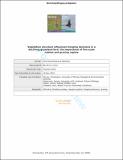Files in this item
Vegetation structure influences foraging decisions in a declining grassland bird : the importance of fine-scale habitat and grazing regime
Item metadata
| dc.contributor.author | Murray, Chris | |
| dc.contributor.author | Minderman, Jeroen | |
| dc.contributor.author | Allison, James | |
| dc.contributor.author | Calladine, John | |
| dc.date.accessioned | 2017-05-12T23:33:43Z | |
| dc.date.available | 2017-05-12T23:33:43Z | |
| dc.date.issued | 2016 | |
| dc.identifier | 242608597 | |
| dc.identifier | b5973160-7374-471f-80cf-ca8a96151e01 | |
| dc.identifier | 84966699904 | |
| dc.identifier | 000378667400009 | |
| dc.identifier.citation | Murray , C , Minderman , J , Allison , J & Calladine , J 2016 , ' Vegetation structure influences foraging decisions in a declining grassland bird : the importance of fine-scale habitat and grazing regime ' , Bird Study , vol. 63 , no. 2 , pp. 223-232 . https://doi.org/10.1080/00063657.2016.1180342 | en |
| dc.identifier.issn | 0006-3657 | |
| dc.identifier.uri | https://hdl.handle.net/10023/10768 | |
| dc.description | Funding: British Trust for Ornithology (BTO) Research Grant. | en |
| dc.description.abstract | Capsule: Whinchat Saxicola rubetra foraging behaviour was significantly influenced by habitat structure and grazing. Aims: To assess how foraging habitats selected by breeding Whinchats differed from wider territory attributes under contrasting grazing management in multiple upland areas in Scotland: principally sheep grazed, Red Deer grazed or ungrazed, and to identify how differing land use may limit suitable foraging areas. Methods: We compared fine-scale vegetation structure in patches chosen for foraging by Whinchats in contrasting grazing management regimes. Results: Whinchats were less likely to forage in patches with a greater cover of bracken and tall non-bracken vegetation, regardless of grazing regime. Grass cover influenced foraging behaviour in ungrazed habitats only, where Whinchats were less likely to forage in areas with high grass cover. Conclusion: Whinchats appear to require a mosaic or range of sward structures within breeding territories, highlighting the importance of establishing how vegetation structure influences breeding birds at different spatial scales. Our results suggest that suitable foraging patches were plentiful within grazed habitats but potentially limited in ungrazed habitats. Further work is needed to identify management regimes and interventions to maintain conditions suitable for breeding Whinchats that are compatible with other land use and conservation objectives. | |
| dc.format.extent | 674715 | |
| dc.language.iso | eng | |
| dc.relation.ispartof | Bird Study | en |
| dc.subject | Whinchat | en |
| dc.subject | Breeding ecology | en |
| dc.subject | Marginal upland | en |
| dc.subject | Foraging behaviour | en |
| dc.subject | Grazing | en |
| dc.subject | GE Environmental Sciences | en |
| dc.subject | QH301 Biology | en |
| dc.subject | QL Zoology | en |
| dc.subject | SDG 15 - Life on Land | en |
| dc.subject.lcc | GE | en |
| dc.subject.lcc | QH301 | en |
| dc.subject.lcc | QL | en |
| dc.title | Vegetation structure influences foraging decisions in a declining grassland bird : the importance of fine-scale habitat and grazing regime | en |
| dc.type | Journal article | en |
| dc.contributor.institution | University of St Andrews. School of Biology | en |
| dc.identifier.doi | https://doi.org/10.1080/00063657.2016.1180342 | |
| dc.description.status | Peer reviewed | en |
| dc.date.embargoedUntil | 2017-05-12 |
This item appears in the following Collection(s)
Items in the St Andrews Research Repository are protected by copyright, with all rights reserved, unless otherwise indicated.

